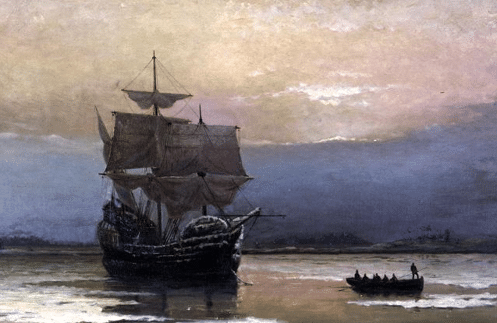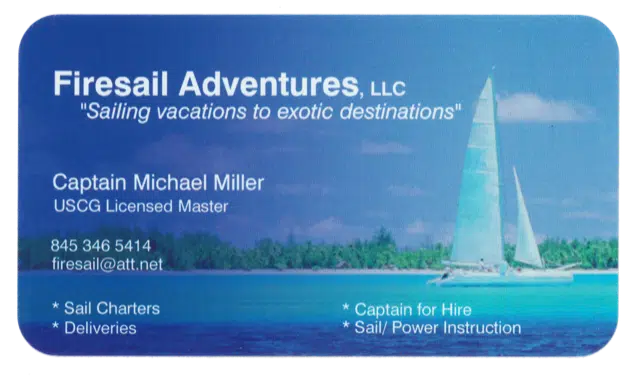Opinion
By Judge John Marshall Meisburg, Jr.
11-06-23
Any discussion of the Christian heritage of America would not be complete without remembering the Pilgrims and the Mayflower Compact.
Who were the Pilgrims? They were Christian “Separatists” who split from the Church of England, or the Anglican Episcopal church, the only legal church in England at that time. They were extremely fervent Puritans, who wanted to purify or reform the Church of England. They believed that the Church of England was very corrupt, and was too formal. They believed that the Bible and Scripture were the primary source of faith, and venerated the literal Word of God, much like modern day Fundamentalist and Charismatic Christians. They were a product of the Reformation, and wanted the people to read the Bible for themselves, preferably in Hebrew, which they called the Holy Language. They called each other Saints. They wanted to start their own church, and elect their own leaders, but the King forbade it. King James wanted to fine people including the Puritans $6,000 a day for not attending church services and then put them in jail. England even passed a law called the Act Against Puritans of 1559. This law drove the Pilgrims out of England to Amsterdam, where they lived for 27 years. They enjoyed religious freedom there, but by 1617 they were anxious to move again because the 30-year war in Europe between Protestants and Catholics was starting.
The Pilgrims saw themselves as modern day Children of Israel, who, like the Jews left the bondage of Egypt for the Promised Land, were heading to a new Promised Land, and a new Jerusalem in the New World. It was a Christian understanding of the Jewish roots of their faith. Their leader, William Bradford, was very familiar with the Hebrew language which he called “the most ancient language, and holy tongue, in which the Law and the oracles of God were written.” Bradford wrote a book called “Of Plymouth Plantation” which includes a whole section of Hebrew, and is the first great writing of American history.
The Pilgrims set sail on the Mayflower ship on September 6, 1620, seeking religious freedom in the New World. There were 102 men, women and children on board the ship. They survived a major storm in which the ship was damaged. After 66 grueling days at sea on the Atlantic Ocean, the Pilgrims arrived at Cape Cod (later known as Massachusetts) on November 11, 1620, some 403 years ago.
Upon their arrival in the New World, on November 11, 1620, the Pilgrims prayed and signed the Mayflower Compact. The opening paragraph is iconic and very important. It says “In the Name of God, Amen. We whose names are underwritten, the loyal subjects of King James, by the Grace of God of Great Britain, Having undertaken for the Glory of God and advancement of the Christian faith and the honor of our King and Country, a voyage to plant the First Colony in the Northern parts of Virginia, do, by these presents solemnly and mutually, in the presence of God and one another, Covenant and combine ourselves together in a Civil Body Politic, for our better ordering and preservation, and furtherance of the ends aforesaid….”
The Mayflower Compact was signed by the 41 male passengers including John Carver, William Bradford and Miles Standish. It is notable that they mention God four times in the first paragraph! It is clear from the wording of the document that the Pilgrims undertook their voyage to the New World for the primary purpose of bringing glory to God and advancing the Christian faith. So we know without doubt that the original founders of America were Christians who sought religious freedom and wanted to start a new country to advance the faith of the Lord Jesus Christ.
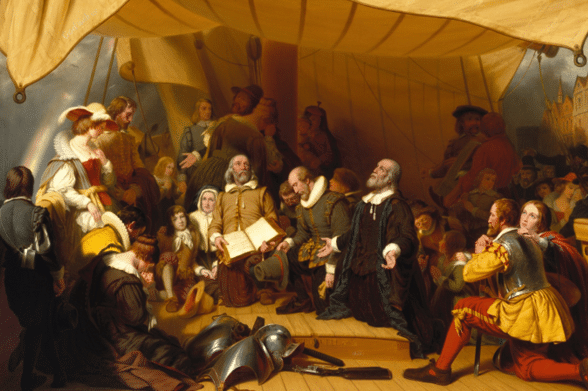
The Mayflower Compact is also a seminal American document because it included the power to enact laws and govern themselves. The consent of the governed was recognized, rather than total submission to the power of the King of England. This was a statement of self-government that later found its full expression in the Declaration of Independence and Constitution of the newly formed United States. The Pilgrims elected William Bradford as their new Governor, which was the first act of self-government in the New World.
A few weeks after they arrived, the Pilgrims sailed up the coast to Plymouth where they built a town where a group of Indians had previously lived. About half of the Pilgrims died in the first winter due to the cold and sickness. A native who could speak English, Samoset, befriended them, and the Pilgrims made a peace treaty with the Wampanoag Tribe of Native Americans and their leader Massasoit. The natives taught the settlers how to plant corn and other crops and how to survive.
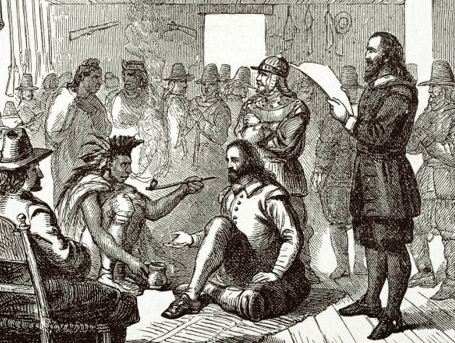
In the Fall of 1621, after the harvest, 90 natives and 50 Pilgrims met together for a feast and to give thanks to God and play some games. Lacking enough food, the natives sent out a hunting party and killed six deer. They also gave thanks to God for life because so many of each group had died in the previous winter. The feast lasted for three days! The 3-day feast was similar to the Jewish Feasts of the Lord, which were venerated by the Pilgrims. So, the Pilgrims and the Wampanoag Native tribe held the first Thanksgiving celebration in America. President Lincoln made Thanksgiving a National holiday in 1863.
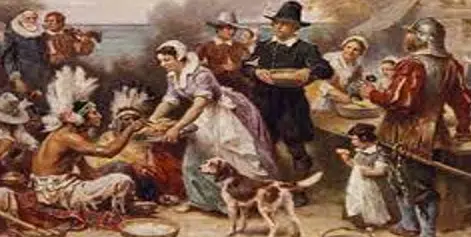
The Pilgrims are an important part of the Christian heritage of America. Like Columbus and the French Huguenots, they made their voyage to the New World in search of religious freedom, and to spread the Gospel of the Lord Jesus Christ. Their Mayflower Compact was also the first act of self-government in America. Our Declaration of Independence and Constitution and Bill of Rights and religious freedom are all part of their legacy. We owe a great debt of gratitude to the Pilgrims for their courage and faith.
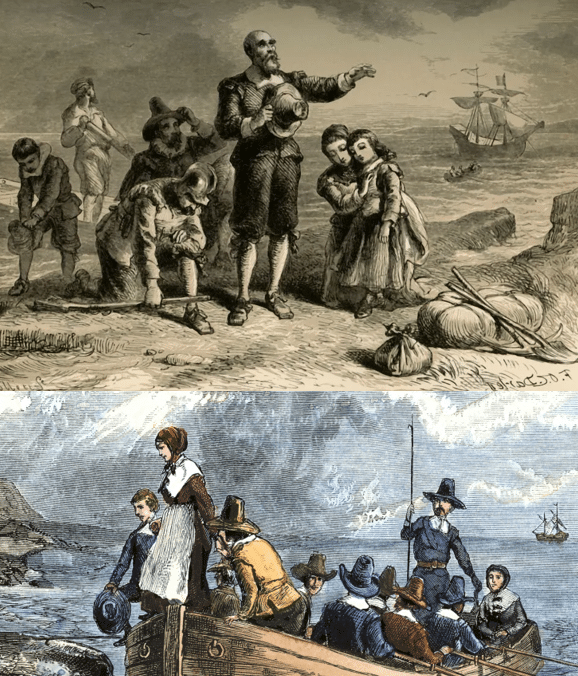
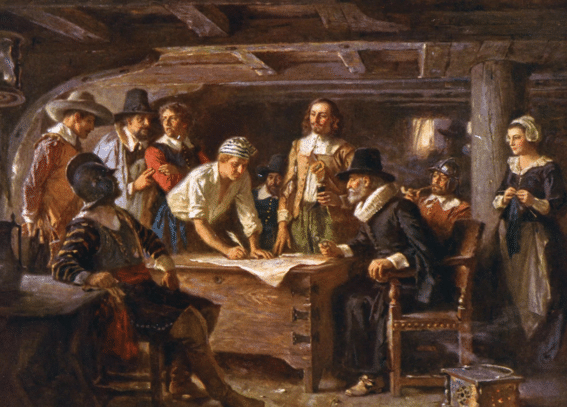
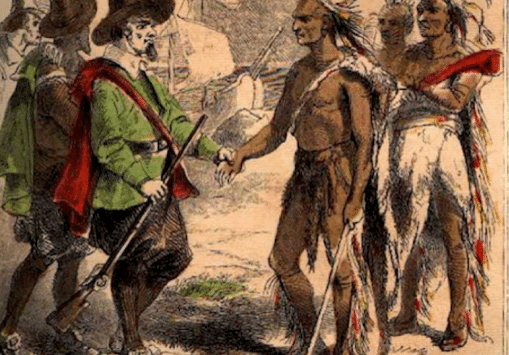
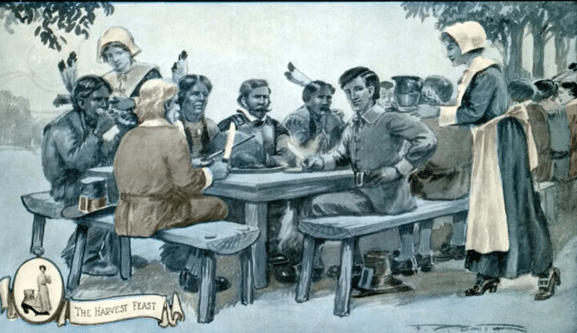
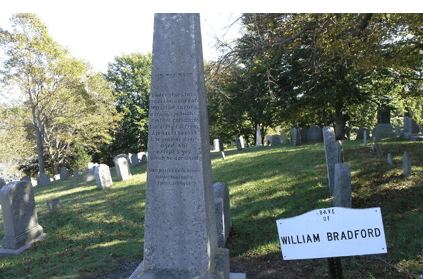
ABOUT THE AUTHOR- JUDGE JOHN MARSHALL MEISBURG, JR.
Judge John Marshall Meisburg, Jr., was a U.S. Administrative Law Judge with the Social Security Administration for 26 years in Jacksonville, Florida. He retired as a judge in 2021 and is now living in Fernandina Beach, Florida with his wife of 43 years, Dr. Denise Meisburg. They have six children and 11 grandchildren. Prior to being a judge, he was a lawyer with the Federal government for 23 years, serving in all three branches of the government, with the U.S. District Court, EEOC, Justice Department, Congress, FDIC and Office of Special Counsel (MSPB). He was in private law practice one year in Washington, D.C. and filed the lawsuit that became the landmark U.S. Supreme Court case on sexual harassment. He holds a Bachelor of Arts in Political Science from the University of Kentucky, and a Juris Doctor law degree from the University of Kentucky College of Law. He is a lifelong Christian, being raised in the Baptist faith in Louisville, Kentucky. He was an Elder at New Life Christian Fellowship in Jacksonville where he taught Sunday School, the Jewish Roots of the Faith and the Christian Heritage of America. He was a leader of both the National Day of Prayer and the House of Prayer in Jacksonville for over ten years. He has published ten books relating to Christian and legal ssues. He is now a member of Living Waters World Outreach Center in Fernandina Beach, where he serves in the prayer and home group ministry, and is a member of the Board of Directors for Faith Christian Academy.
The views expressed in this commentary are those of the author and do not necessarily reflect the official position of Citizens Journal Florida.


